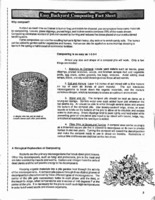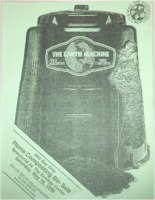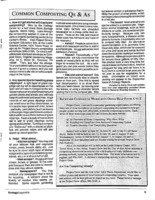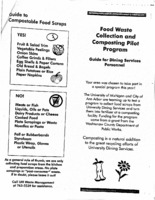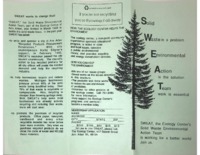Composting and Commercial Recycling
Composting is as easy as 1-2-3-4. Easy Backyard Composting Fact Sheet, March 1988
The goal for Ann Arbor’s solid waste management heading into the 1990s was simple: remove materials from the waste stream and toward other means of disposal. The Ecology Center supported such a mandate through their Mandatory Recycling Ordinance of 1988 and the Environmental Bond of 1990, which provided funding for the Materials Recovery Facility (MRF). In collaboration with local non-profits and Recycle Ann Arbor, two specific solid waste initiatives also emerged: composting and commercial recycling.
Composting
The Ecology Center had informally championed composting as an alternative to chemical fertilizers during the anti-pesticide campaigns of the 1970s and 1980s. Starting in April 1990, after the discovery that compostable material comprised 10-15% of the waste stream, composting became a part of regular curbside collection The City of Ann Arbor distributed collection bins and scheduled compost collections on the same days as trash collection.
The Ecology Center played a key role in informing members of the public how this collection would work. Similar to the work of the block coordinators in the early days of Recycle Ann Arbor, the Ecology Center published detailed information about what materials could be composted. Partnering with Project Grow, the EC hosted information sessions about compost at the Leslie Science Center, and explained how compost could be turned into humus, or soil conditioner. The city’s plans for humus included using it for downtown planters, parks, and the final layer on top of the Phase II landfill.
Aside from promoting city curbside collection, the Ecology Center also encouraged Ann Arborites to practice composting at home. In the fall of 1992, the EC and Project Grow tested out a home composting program. For $25, they would install a compost bin in residents’ backyards and demonstrate how to use the composter. In the summer of 1996, this initiative expanded to a compost bin sale, which sold 740 "Earth Machine" compost bins in a single day.
Thanks to the leadership of Rebecca Kanner, the Ecology Center was also represented on the Washtenaw County Consortium for Solid Waste Management. In the autumn of 1996, the organization introduced a five-week “Master Composter” curriculum. This program offered a comprehensive guide to home composting. Held at the Washtenaw County Library Learning Resource Center in Ypsilanti and the Leslie Science Center, the program covered everything from building a compost pile to grass recycling to taking a tour of the MRF. Participants learned what breed of worms to use in their compost, how to reuse grass clippings, and about volunteer opportunities with other local composting initiatives.
Commercial Recycling
Though a smaller initiative when compared to composting, commercial recycling sought to include Ann Arbor's businesses in the recycling process. Recycle Ann Arbor led the first commercial recycling pilot program from 1991-1992. The program was crucial for the city’s solid waste department as a way to study the kinds of materials being diverted from recycling without commercial recycling in place. Over 120 local companies participated across a range of sectors including retail, office, and business collection, food service bottle and can collections, and special event collections such as during the Art Fair or football games. The success of the pilot program led to the creation of the Ann Arbor Commercial Recycling Task Force, which was active from 1992-1996.


